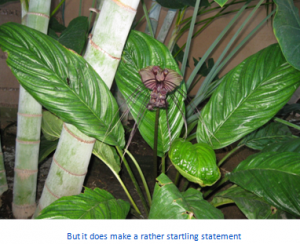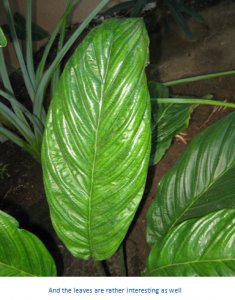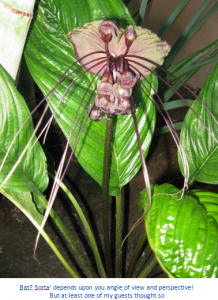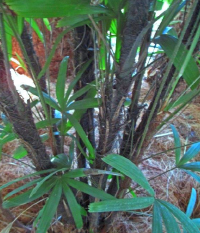By Tommy Clarkson from the April 2017 Edition
Family: Dioscoreaceae
Also known as: Bat Plant, Cat’s Whiskers, Devil Flower, Black Bat Flower, Bat Head Lily, Devil’s Tongue, Black Tacca, Jews Beard or Voodoo Flower
This distinctive flowering plant is native to Myanmar (Burma to us old-timers) and Thailand (Siam to the really old-timers). By way of the simplest description, the Bat Flower blooms on a stem from the plant’s center in a cluster of purple flowers. But these have not the appearance of a young child’s basic, simple petaled posies!
In actuality, dependent upon the stage of flower maturation, with its wing-like bracts spread out, they can look like a bat in full flight or, with bracts unfurled, reminiscent of a bat at rest, hanging upside down! (Predescription and explanation, I actually had a garden visitor bend down to take a close look, register facial shock, shriek, and jump back with heart racing a mile a minute!)
 But knowing of, and anticipating, its attractiveness, don’t rush forward with expectations of a fragrant scent matching its unique appearance. The flora like that of the Star Fish Flower emanates a not so pleasant odor, similar in smell to that of rotting meat, which attracts flies and hence helps in the pollination process. Pretty tricky this flower!
But knowing of, and anticipating, its attractiveness, don’t rush forward with expectations of a fragrant scent matching its unique appearance. The flora like that of the Star Fish Flower emanates a not so pleasant odor, similar in smell to that of rotting meat, which attracts flies and hence helps in the pollination process. Pretty tricky this flower!
The Bat Flower is one of ten species in the Teccaceae genus of tuberous perennial herbs. They come from Southeast Asia like our subject plant including Malaysia, Australia, Africa and South America.
Tecca chantrieri plant, itself, may only grow to between twenty-four to thirty inches (60.96-76.20 cm) in size. Its large ten to twenty-two inch (25.40-55.88 cm) long, glossy, dark- green leaves are basal (this simply means that they originate at the plant’s base) and lanceolate to oblong in shape.
But those blooms can be as much as a foot (30.48 cm) across with its long whisker shaped appendages reaching another twenty-eight (71.12 cm) inches. They bloom, primarily, during the warmer season after they reach two to three years of age. These intriguing flowers generally begin after the plant has produced two to three full size leaves.
another twenty-eight (71.12 cm) inches. They bloom, primarily, during the warmer season after they reach two to three years of age. These intriguing flowers generally begin after the plant has produced two to three full size leaves.
The black to purplish white flowers for which it was named have numerous long filamentous bracts . . . this latter word, you may recall, being a modified leaf affixed below the flower. (The White Bat Flower [Tacca integrifolia] has well, duh white “wings.”) Both have six-ribbed, berry-shaped fruit which are approximately five-eighths of an inch to one and five-eighth inches (1.59-4.13 cm) in size.
If you are pot inclined no, I meant that as to in what you grow your Bat Flower they prefer a somewhat wide, shallow pot with soil as described below or, if you want to get fancy, a mix of approximately 50% pine bark, 40% peat moss, and 10% sand. The Bat Flower should be only grown outside, in the ground, if one lives in the tropics or sub-tropics so you can easily guess where ours is permanently located!
Out of doors, they like good air circulation and roots planted in moist, composty soil that is well draining in partial shade but protect them from heavy rain. Should you wish to expand your family of Bat Flowers, you may do so by root division or seeds . . . the former is usually much easier!
The Bat Flower wants its soil consistently moist. (Inside, simply place a saucer underneath.) If you’ve the time, feeding it a wa- ter soluble orchid fertilizer bi-weekly would be appreciated or employ a slow release fertilizer at intervals as directed on its package. Inasmuch as they prefer a humid climate, misting may be a recurring task when watering particularly inside. If grown in a pot, move to a larger one when it becomes root bound. Do so in the spring, following flowering, before new growth emerges. During this repotting, divisions can be removed to start new plants while the older rhizomes may be trimmed of leaves and roots and placed back into their original pot homes.
Generally pest and disease free, I have read that it can be subject to Black Spot fungal disease.
Yes, these blooms are amazing but they do not make good cut flowers for interior arrangements as they wither fast and die. Similarly, let their old flowers fully die back before removal. Keep in mind that Tacca chantrieri are evergreen plants, how- ever they (like me) have need of a rest period. During their dormancy, they’ll retain their leaves but will simply stop growing.
Now that’s all pretty simple, right?
Download the full edition or view it online
—
Tommy Clarkson is a bit of a renaissance man. He’s lived and worked in locales as disparate as the 1.2 square mile island of Kwajalein to war-torn Iraq, from aboard he and Patty’s boat berthed out of Sea Bright, NJ to Thailand, Germany, Hawaii and Viet Nam; He’s taught classes and courses on creative writing and mass communications from the elementary grades to graduate level; He’s spoken to a wide array of meetings, conferences and assemblages on topics as varied as Buddhism, strategic marketing and tropical plants; In the latter category he and Patty’s recently book, “The Civilized Jungle” – written for the lay gardener – has been heralded as “the best tropical plant book in the last ten years”; And, according to Trip Advisor, their spectacular tropical creation – Ola Brisa Gardens – is the “Number One Tour destination in Manzanillo”.





